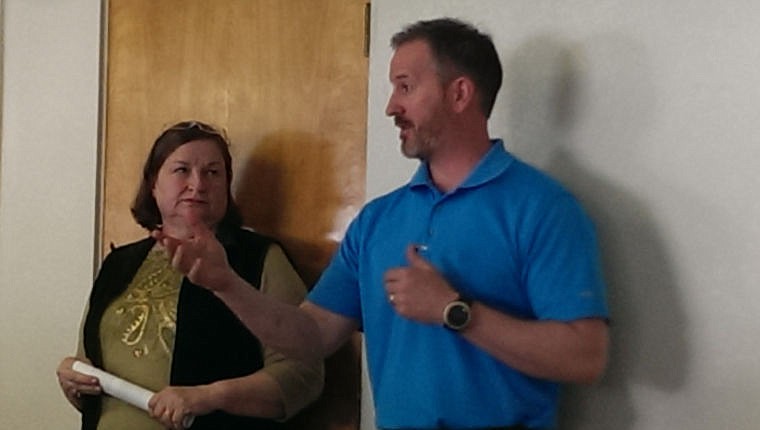SPS holds informational session
SUPERIOR – Several representatives from Superior Public Schools presented to the Superior Senior Center April 30 showing evidence of the decaying junior high school. The $3.99 million bond levy the school is seeking is for a new junior high school and additional upgrades to the other buildings in the district.
SPS wants voters to say yes on June 3 to replace the existing junior high building, which the school says is outdated and no longer safe for students and staff to be in.
Those in attendance listened to an exhaustive list of building problems and health concerns at the junior high building.
“The purpose of these meetings is for us to inform the community and give everyone the information we have,” said Allan Labbe, Superior High School principal.
The current junior high building was originally built as a grocery store in 1961, which was converted to a school a few years later, according to information presented.
“The main problem we are having is with security concerns,” said Hugh Hopwood, maintenance supervisor for SPS. “Anybody can come in or out of the junior high building at any time unchallenged.”
The Superior staff is concerned with security because the building is not up to code for the possibility of violent events, which could target public establishments.
“Somebody who has a problem with a teacher or student and wants to do harm can come and go and there’s no way of knowing until after the fact,” Hopwood said. “We have security cameras in the building but the problem is that they’re not constantly monitored.”
As a teacher, Beth Keyser is also worried about the lack of security at the junior high building.
“From my point of view, one of the biggest things for me is the safety of the children,” said Keyser, English teacher at the junior high school. “Never as a teacher would I have thought that somebody could come in and harm me and one of my students. With all the shootings across America lately, it’s scary.”
Another worry is that city streets surround the building. Vehicles come and go all day long. The kids, as well as the staff have to cross those streets back and forth between the buildings.
“The other concern of mine is that when I’m watching kids outside during recess, they’re playing football, or whatever and run out into the road without looking,” Keyser said. “Sometimes people are driving and they stop and talk to the students and I don’t even know who they are and that concerns me.”
Hopwood also elaborated on the problem with the building fire furnaces.
“Two have cracked fireboxes and are leaking exhaust gas into the school,” Hopwood said. “These are gases the teachers and students are breathing. The third furnace has no fresh air intake. It doesn’t pull air in from outside; it pulls air in from the room.”
Although the air is filtered, the majority of the air contains iron residues from the shop plasma cutter, for example.
“The gases that are vented into the building contain some very nasty chemicals,” Hopwood said. “If some of the chemicals are mixed with water in your lungs, it could turn into sulfuric acid. I’m not saying it’s going to eat a hole right through your lungs, but it is dangerous stuff.”
Additional problems with the furnaces are that they are pressurized fuel systems.
“If the furnaces are up overhead, you have to pump that fuel to them,” Hopwood said. “If you get a hole in one, in any of the fuel lines, it can empty that fuel tank right into the roof of the school.”
The school shop is a concern in the junior high school because administrators and teachers believe its not properly ventilated.
“The shop furnace has no intake for fresh air,” Hopwood said. “That’s where its pulling the air in, and if that particular furnace starts leaking fuel, then the kiln for the pottery, which is fire operated, is right next to it.”
From a classroom perspective, Keyser said that students and teachers smell fumes from the shop class often.
“It’s not ventilated correctly and it’s not healthy,” Keyser said.
Other issues with the building include outdated single pane windows that lose heat, and a collapsing floor in the shop and paint room.
“The floor has actually dropped down about two to three inches,” Hopwood said. “Underneath it there is no floor support, just particleboard. No floor joints. Just a pad of concrete.”
The collapsing floor was noticed after a flood occurred. Hopwood said there was so much snow this year that a massive wall of water came down from the track when the melt occurred.
“There is a dry well next to the building, which filled and backed up into the doors and into the building,” Hopwood said.
In addition, the sewer floor drains also backed up into the hallways twice at the same time the building was flooded.
“There is mold underneath the collapsing floor in the paint room, but there is none in the classrooms,” Hopwood said. “But if that floor collapses it can go right into the walls, all bets are off.”
The teachers and staff in attendance believe that the time is now for the upgrade, and if approved construction would start immediately.
“This project is a no amenities project, which means we would only be building classrooms for the kids so they can be healthier and safer, including the teachers,” Keyser said.

